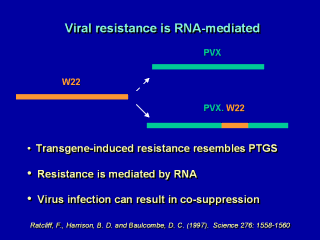| front |1 |2 |3 |4 |5 |6 |7 |8 |9 |10 |11 |12 |13 |14 |15 |16 |17 |18 |19 |20 |21 |22 |23 |24 |25 |26 |27 |28 |29 |30 |31 |32 |33 |review |
 |
Cross-protection between viruses -- these have
RNA genomes for the most part -- is a function of their sequence similarity.
1. Baulcombe’s lab showed that cross-protection between viruses that normally don’t cross protect could be transferred by introducing a sequence from one into the other in such a way that it does not affect expression of the viral proteins. 2. This implies that the viral RNA itself can trigger a process in which closely related sequences are targetted for destruction (or, perhaps, aborted replication). 3. When a plant is infected with a virus into whose genome a copy of either an endogenous plant gene or a resident transgene has been inserted, the resident genes are silenced, much as is observed with co-suppression. All of these observations suggest a close relationship between the induction of viral immunity and PTGS. |